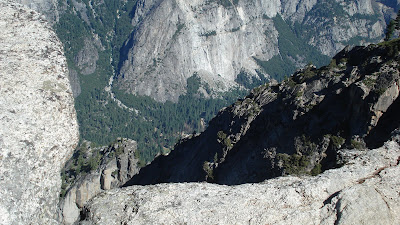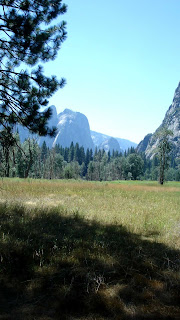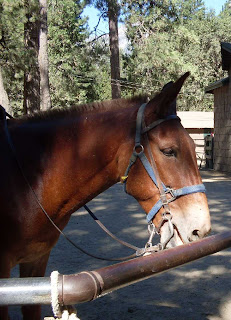In Which We Reach the Literal and Figurative High PointOne trouble with camping is cramming everything into each day. Inevitably, one comes up with ways to force oneself to rise early. The previous night's ursine interruption made the night all the much shorter, but we were determined to stick to the plan and hike from Tuolomne Meadows.
In my ill-informed opinion, the best thing in Yosemite National Park isn't in Yosemite Valley at all. It's not exactly a best-kept secret, either: it simply isn't for everyone.
Tuolomne Meadows is a region of high-altitude, back-country meadows, streams, granite domes and canyons some 15 miles as the raven flies Northeast of Yosemite Village. It's more than four times as far by road, and is also higher: higher than all but a few Yosemite Valley landmarks. The long road into the Meadows is one reason this isn't everyone's cup of tea. The other is the significant drop-off in amenities. The main reasons people come to the Meadows are rock climbing and wilderness hiking. Em had been there once for the rock climbing. As day hikers, we were somewhat exceptional.
In Yosemite Valley, the valley is your view. With rock walls vaulting straight up 3000, 4000 and more feet at every hand, that's inevitable. The Meadows take the visitor to the edge of the really high country, the part where they get the
high in High Sierras. Views are long, but distant vistas compete with an astoundingly beautiful landscape closer by.
We had already been warned that one amenity in very short supply was parking. A given day's inbound traffic tells you nothing about that day's parking supply, because it's nothing for wilderness hikers to come to the Meadows, park, and be gone for a week. Another one is--wait for it--rest rooms. There a couple of chemical privies at trailheads on the way in, so we had prepared ourselves on that front. Em found a place large enough for her Civic hybrid and we were off.
Our route of choice was to go up Lyell Canyon, more or less as far as we could. The trail is the first link in a series that takes one either very deep into the Sierras, or back to Yosemite, should one feel ambitious enough to walk back there. The first odd check was a working party on the first of several bridges that cross the Lyell Fork and its branches. The detour signs at first seemed to go nowhere. The workers, seeing our confusion, happily gestured downward to their homemade detour: a one- plank bridge across this small, swift river.
Over my years of work I've had much to do with the National Park Service in general, and their Legal Department in particular. I'm sure that august body had never signed off on this
ex-tempore bridge. If they were to get wind of the details, I can easily imagine the conniptions. We all crossed without incident; I did feel I was getting even for a couple of past run-ins. We somehow neglected to get pictures of the bridge, supporting what I'm sure was the workers' credo: it's easier to get forgiveness than permission.
Up the Lyell CanyonMy wife had found out that there are various
back-country camps in Yosemite, of which the Tuolomne Meadows facilities are the epicenter. We had been speculating about how these relatively posh camps got provisioned. The
Appalachian Mountain Club's Huts in New Hampshire's White Mountains run on much the same idea, over shorter distances and higher climbs from their base facilities. They are provisioned by the hut staff, literally on human backs. When we entered the Meadows, we saw a couple of mule trains heading into the hills. We still didn't cross the Ts until we had crossed Lyell Fork by the ersatz bridge. Our first sight was a mule train, followed closely by another. There was yet another before we had gone much over an hour, as well as plenty of evidence of equine traffic on the trail. For men, it is said, all the world's a urinal. This is so much more true of mule trains. Worse, when one animal decides it's time to go, often they all do in succession, leaving hikers to negotiate a couple of hundred feet of trail studded with mule poop and puddles of mule piss. (It doesn't sink in, remember?) Now you don't see this in the White Mountains. Light dawned and we finally figured out that this was the back-country camps' supply line.

Some time after meeting the first two mule trains, we began to wonder if we were headed in the right direction. Right on cue, the Lyell Canyon trailhead sign appeared, which showed us that we'd walked a mile and a half and had not really started yet: big country, this, as well as high.
Our next landmark was less than half a mile on, when we reached our second crossing of the Fork. It was here, going up and coming down, that we had a reminder that not everyone who treks into Tuolomne Meadows is a dedicated hiker possessed of common sense. The bridge crossing offered the first of several dozen views for which the term breathtaking is, and about all the adjectives are, far too trite. As we paused to assimilate this, the first party not at all interested in hiking began to appear behind us. They weren't here for the hiking except to walk, past the signs reminding people how dangerous are the currents, with their inflatable toys and jump into the water. Never mind them; here's the first view.

You notice right away that, as easterners, we have the wrong idea of the term "canyon." Evidently it's a rather limber expression. I had certainly expected something a little narrower. What Lyell Canyon offered was relatively closed-in stretches alternating with mountain meadows like this. The guidebooks all advertised this trail as flat. Here again, I must remind you that flat, in this part of the world, is relative. The Lyell Canyon trail didn't climb much, but it climbed up or went down all the time except in the meadows.
By the time we had reached the Lyell Canyon trailhead, we had gotten well above 8000 feet. Bearing Monday's experience in mind, I had come well-supplied with aspirin, which I munched in lieu of trail mix. The spirit of Dr. Morton proved to be still with me, determined to prove his hypothesis at the expense of toe and my mood. However, scenery like this is not to be wasted. I trudged on, again in my default position between my wife the marathon hiker and my daughter the photographer.
Ansel Adams Moments
The one thing one can absolutely count on along this trail is
Ansel Adams moments. As rare day hikers, we were alone a good deal of the time. Back-country hikers would pass us, heavily laden, going up, and we would not see them again. At the Ireland Creek crossing, the last back-country trail branched off the Lyell Canyon Trail. We estimated that we were now 3.5 miles out (actually, more like 4.5 according to the map in front of me now) and began to think about a lunch spot.
Far in the lead, our fearless point person's bladder was beginning to play her false, so she too was thinking of a stop, for different reasons. We were now far, far away from the nearest necessary, and Em's advice from Monday began to resonate.
We turned on a side trail toward what seemed a likely lunch spot. En route, Mom found her tree. At the river's edge, Em and I found the Ansel Adam-est moments of all. Here's a sample: words do fail me.



Our resident photographer kept busy for most of our lunch break, with the result that she had to find her own tree soon after, and under less auspicious conditions: for the first time in nearly three hours, we had human company.
The surest proof of our altitude was our non-human company, high-altitude mammals,
pikas first of all. These charming little creatures, distant relations of the rabbit, live above 8000 feet. They are supremely adapted to life in cold places, and gravely endangered by the steady creep of higher temperatures up the Sierra slopes. Our chief pests in the campground had been squirrels, and we had first taken them to be
Belding's squirrels. Now that we were high enough to see the real thing, it was clear there was no resemblance.
About 45 minutes past our lunch break, Dr. Morton was winning, and in any case I had to assert my duty as resident timekeeper. Em wanted to be at
Tunnel View in Yosemite for sunset photography, so we had to turn back in time to make that possible.
If you want to be unpopular in a party of three, first, be the only one with a watch. Second, be the only one to have mastered the art of back-timing, which is being able to estimate how long it will take to get back to a given starting point based on the time elapsed. I said I would happily wait where we were, or start back slowly, if the Pathfinder wanted to go on, but in that case we wouldn't make Yosemite Valley in time for sunset photography. The upshot of this tense moment was that we'd turn around. I obtained dispensation to take lines of sight with my bearing compass, to confirm how far we'd come, before we headed back. We had passed the 9000 foot contour, and were within a few hundred metres of the head of valley.
Our first impression was that we'd made what the point person considered was a very unsatisfactory round trip of barely eight miles. Review with the National Geographic small scale map shows the round trip was somewhere between 10 and 11 miles, which should satisfy anyone, including Dr. Morton and the chip on his toe.
Starting Back in Wild KingdomOur trio headed back in somewhat imperfect humour, but we had no time to think about that. Two returning hikers whispered "coyote" as they passed us, and pointed. The coyote was some 30-40 metres off up the slope, completely unconcerned by the presence of five humans. It slipped into some underbrush, and we lost sight of it.
However, our other non-human company hadn't. We had not gone long down the trail when we began to see one Belding's squirrel after another pop out of its hole, get right up on stretched hind legs (see the link) and give a piercing whistle. Further off there were other calls; probably the pikas. We soon saw what the squirrels had already detected: either the same coyote or another one, this time working its way up the slope toward the trail and the squirrel colony. We at least couldn't see a coyote uphill, but that's no proof one wasn't there.
We stayed as long as we thought we could without interfering, then withdrew as quietly as possible.
The only other interesting wildlife we saw on the return trip was, first, a park ranger hurrying up the trail with a shovel. We couldn't help wondering whether he had drawn official mule-pooper-scooper duty. When we got further down, there was clear evidence that he had scooped no poop.
Second, when we reached the Lyell Fork bridge with the drop-dead view, we found that the rubber ducky folk had become a crowd. One man had even lugged a very large watermelon up on his shoulders. Em and I agreed it would be a shame to mention to him how fond bears are of things like watermelon. Even though we reached the first bridge about quitting time for the work crew, the plank detour was still there... and the NPS lawyers weren't.
As the official timekeeper had predicted, time was pressing by the time we reached the parking lot. (The official timekeeper thought it politic not so say "I told you so.") Time wasn't the only thing pressing, so we decided to schedule our pit stop for Crane Flat, the last NPS outpost before getting into the high country.
It was not entirely heads-down urgency. As we passed the various rock-climbing sites, Em discussed the different types of rock climbing, and identified what each party had been doing based on their equipment. This was impressive learning. However, I was distracted by other sportifs I haven't yet mentioned.
Cyclists make their way to Tuolomne Meadows to camp. Note that I say "make their way," since the sixty-some miles of road from Yosemite Village to the Tuolomne Meadows campground is comprised of upgrades averaging over 12% for miles at a time, interspersed with a few similar downgrades, on a narrow road with no shoulders to speak of and enough traffic to give one pause. Most are doing this pleasure jaunt on fully loaded touring bikes. About a dozen miles out of the Meadows we saw, going downhill, a couple whom we had overtaken going uphill from Yosemite Valley toward Crane Flat that morning. Em commented that she sure hoped they had campground reservations. There had been sites available when we entered the Meadows that morning, but the sold out sign was up when we left.
We made it back to camp with just over an hour to spare before sunset, so Em dumped the parental units and hightailed off to Tunnel View. Here I must share the conspiracy theory Em and I evolved over the week. In Part 1, I mentioned the one-lane bridge on CA 140. On CA 41, the main North-South route to Yosemite, there are this year several miles of highway construction: as in, rip up all the hardtop and start over construction. They work 7 p.m to 7 a.m, so enjoying sunset at the Tunnel View outlook is a matter of very good timing. The third route, the one we had taken back from Crane Flat, was partially blocked by a car fire when we returned.
Our story--and we're sticking to it--is not that NPS wants to keep tourists out, but that they want to keep them in. So they make it as difficult as possible to get out once they get in.
Dinner came and went, and quiet hours arrived at Housekeeping Camp without bear incidents. This didn't prevent my wife from going to bed with a couple of pots and pans to pound if any unwelcome guests stuck their noses into the shelter.
Later in the night, most of the camp was awakened by gunshots and calls of "Bear, bear! Get out, thief!" Again, we refer to the NPS playbook. Rangers patrol at night armed with loud voices and rubber bullet guns. This is supposed to frighten and discourage marauding bears. It's unclear what effect it has on bears, but it works very well with certain visitors.
I confess to sleeping soundly through the whole racket.
Labels: travel, Yosemite National Park





























